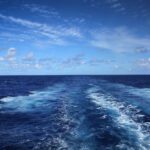In this series, we’re sharing practices of community-engaged research (CER): researchers and community partners working together to advance community goals and science.
Fisheries of the forest
Crabs are the subject of intense fishing pressures the world over. We typically associate crab fisheries with larger commercial vessels and trapping pots, catching crabs from the depths of the sea or tropical seagrass meadows. Lesser known however is the artisanal harvest of their terrestrial cousins, the land crabs. This photo diary highlights initial efforts in The Bahamas, conducted at the Cape Eleuthera Island School, to better understand the physiology and ecology of the crabs and highlight their importance in Bahamian culture and tradition.
Cryptic crustaceans
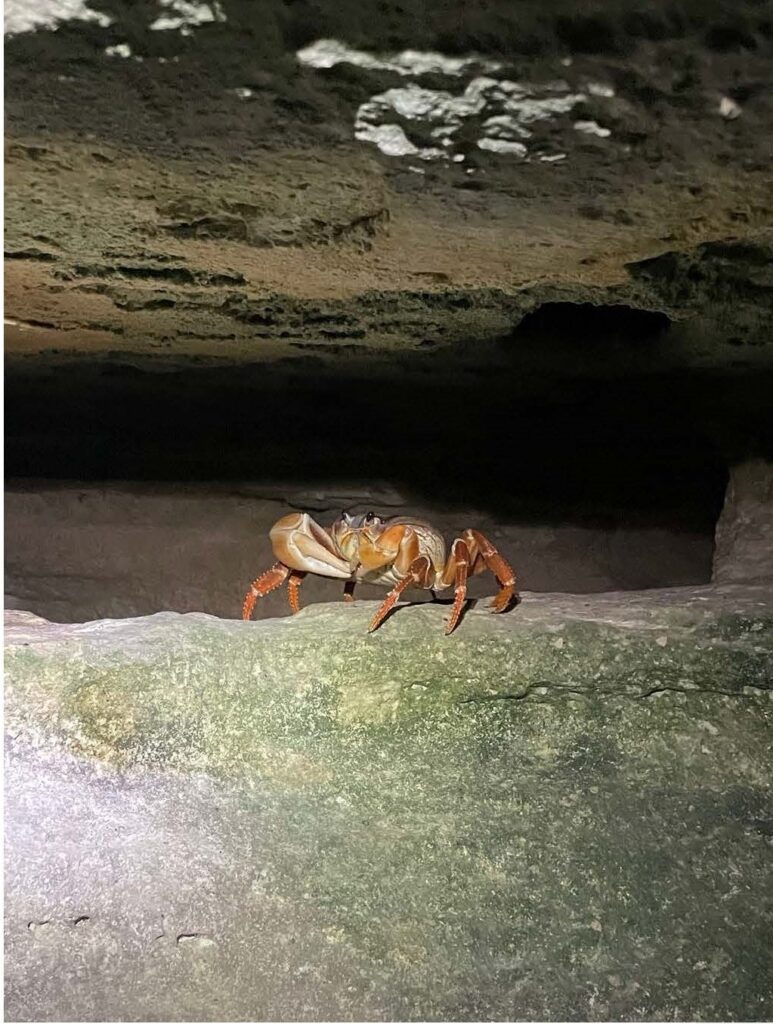 We can trace the lineage of land crabs back roughly 125 million years to marine ancestors which came to colonize land multiple times throughout their evolutionary history, adapting to a variety of coastal environments. Fascinatingly, despite having evolved to survive almost independently of the sea, they retain much of their ancestral anatomy. Land crabs can be found in cryptic microhabitats such as burrows, or deep within rocky crevices. They have been documented many kilometres from shore at remarkable elevations, making their successful transition to land a compelling area of research.
We can trace the lineage of land crabs back roughly 125 million years to marine ancestors which came to colonize land multiple times throughout their evolutionary history, adapting to a variety of coastal environments. Fascinatingly, despite having evolved to survive almost independently of the sea, they retain much of their ancestral anatomy. Land crabs can be found in cryptic microhabitats such as burrows, or deep within rocky crevices. They have been documented many kilometres from shore at remarkable elevations, making their successful transition to land a compelling area of research.
The black land crab (Gecarcinus ruricola)

In the Caribbean, the harvest of land crabs dates back to the traditional practices of the indigenous Taíno. Today, the crabs continue to serve as an important source of protein, as well as serving as a large economic driver within small island communities. On a good night, harvesters report catching many dozens of crabs which are either kept for personal consumption or sold live to hungry crab connoisseurs. In The Bahamas, crab dishes such as crab n’ dough, crab n’ rice, or stuffed crab are a staple of the traditional gastronomy.
Learning from stakeholders
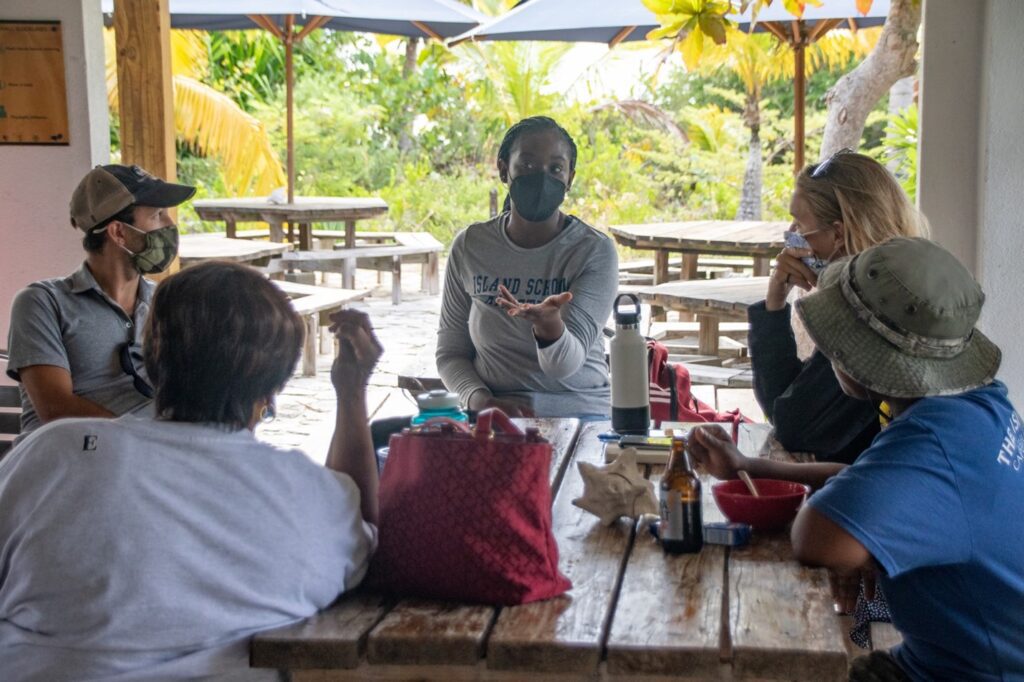
Ms. Mitzy Sweeting (pictured centre) of South Eleuthera shares her experience hunting land crabs in the forests. Stakeholders in the fishery often describe making spawning runs to the ocean following early summer rains, typically on dark nights associated with the new moon. This wealth of traditional knowledge provides critical insight into the crabs’ ecology and current threats such as overharvest and coastline development. Ms. Merlene “Mooch” Munnings (pictured bottom left) recounts days on Eleuthera when black land crabs were far more plentiful and attributes their decline to the destruction of the crabs’ habitat.
Go in the bush!
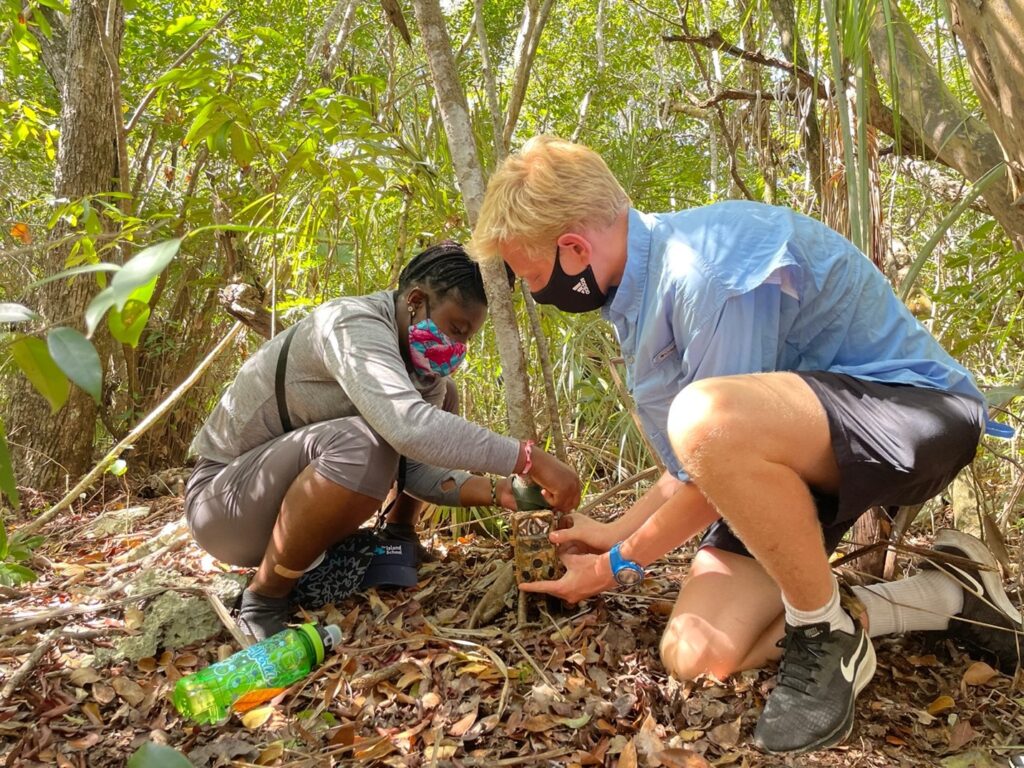
Photo credit: Cape Eleuthera Island School.
Much of what we know about black land crabs has been learned during their annual spawning season, which is when they’re most conspicuous. Island School students, Mr. Brendan Howard and BESS Scholar Ms. Dominique Bowleg, deploy a baited camera trap deep within the coastal forest of Eleuthera, commonly referred to as “the bush.” The traps provide novel in situ observations of the crabs before, during, and following the spawning run, helping paint a better picture of the secret life of black land crabs within the forest. Traversing this ecosystem is not for the faint of heart—these woodlands are populated by skin irritating trees such as poisonwood (Metopium toxiferum) as well as intimidatingly large predators such as the Bahamian boa (Chilabothrus strigilatus.)
Smile, you’re on camera
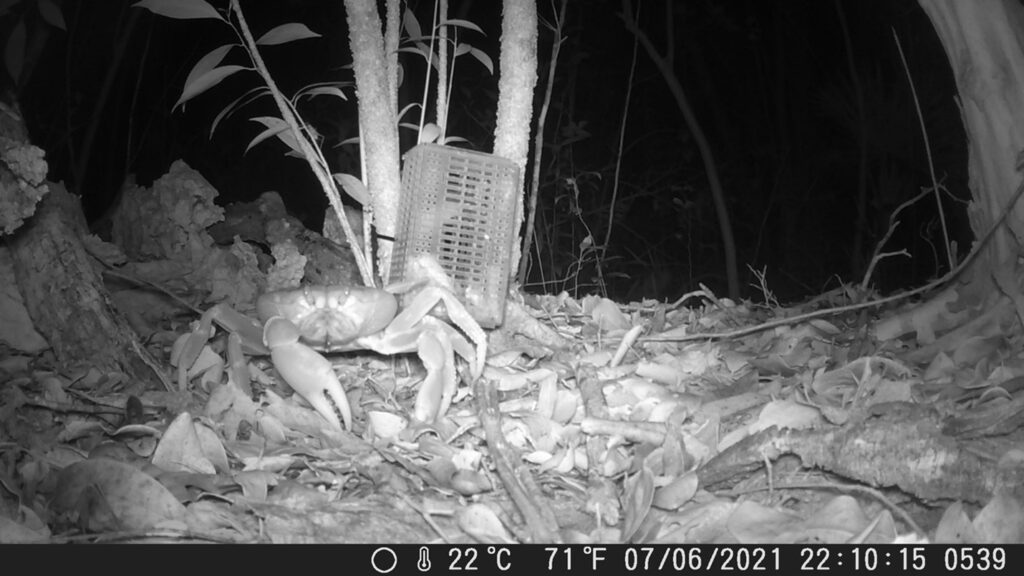
A large black land crab emerges from the darkness to inspect a novel scent. Just as harvesters have described, the crabs demonstrate increased levels of activity during very specific conditions—camera capture events correlate to rainfall, lunar illumination, and relative humidity. Under the protective canopy of the coastal forest, the crabs can remain active well past the peak in June typically described on Eleuthera.
In the Canadian Journal of Zoology:
“From color to shape: ontogenetic shifts in traits of the freshwater crab Dilocarcinus pagei (Brachyura: Trichodactylidae)”
Working in the crab lab
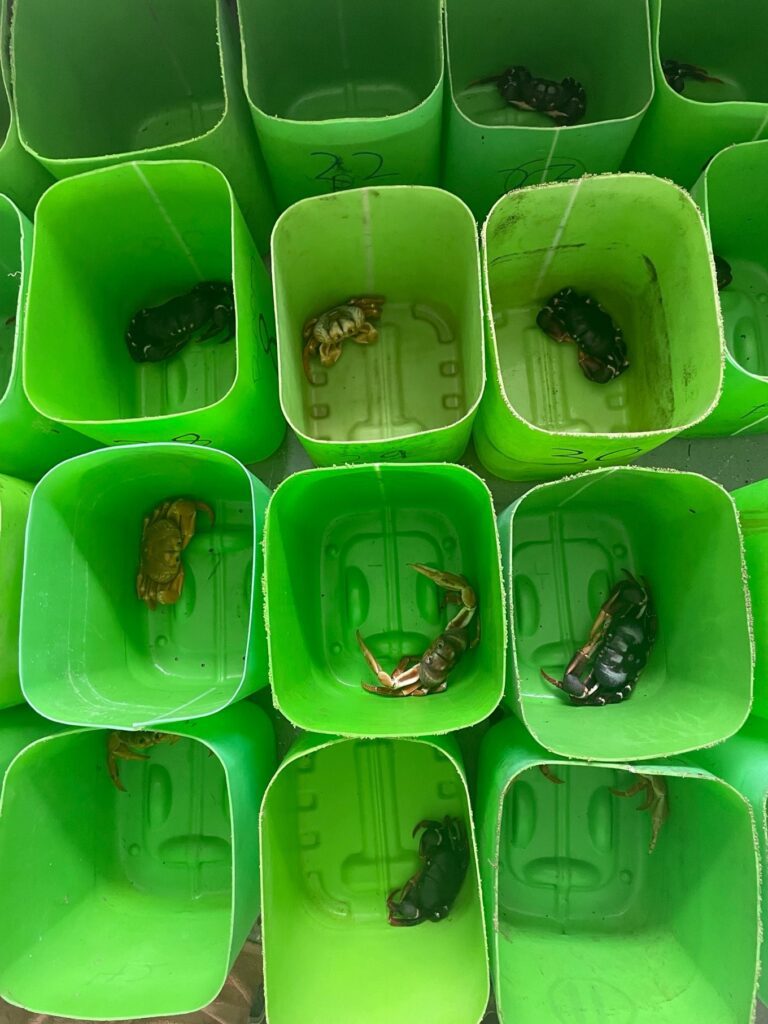 Unlike their marine cousins, land crabs are limited in their access to water and electrolytes, both of which are of critical importance for sustaining life functions. To better understand how the crabs meet their water and ion requirements, our team conducted laboratory experiments to assess how the crabs take up moisture from their environment and stave off dehydration. Results suggest that freestanding water, like puddles following rainfall events, provide the most effective means of maintaining hemolymph (crab blood) concentrations. However, regions such as The Bahamas experience distinct rainy and dry seasons, yet the crabs can remain properly hydrated year-round. Additional results demonstrate that the crabs take up moisture from the damp forest soil through specialized channels in their walking limbs. This paints a clearer picture of the role the coastal forests play in providing the necessary habitat for the crabs to thrive.
Unlike their marine cousins, land crabs are limited in their access to water and electrolytes, both of which are of critical importance for sustaining life functions. To better understand how the crabs meet their water and ion requirements, our team conducted laboratory experiments to assess how the crabs take up moisture from their environment and stave off dehydration. Results suggest that freestanding water, like puddles following rainfall events, provide the most effective means of maintaining hemolymph (crab blood) concentrations. However, regions such as The Bahamas experience distinct rainy and dry seasons, yet the crabs can remain properly hydrated year-round. Additional results demonstrate that the crabs take up moisture from the damp forest soil through specialized channels in their walking limbs. This paints a clearer picture of the role the coastal forests play in providing the necessary habitat for the crabs to thrive.
It’s a dirty job, but someone has to do it
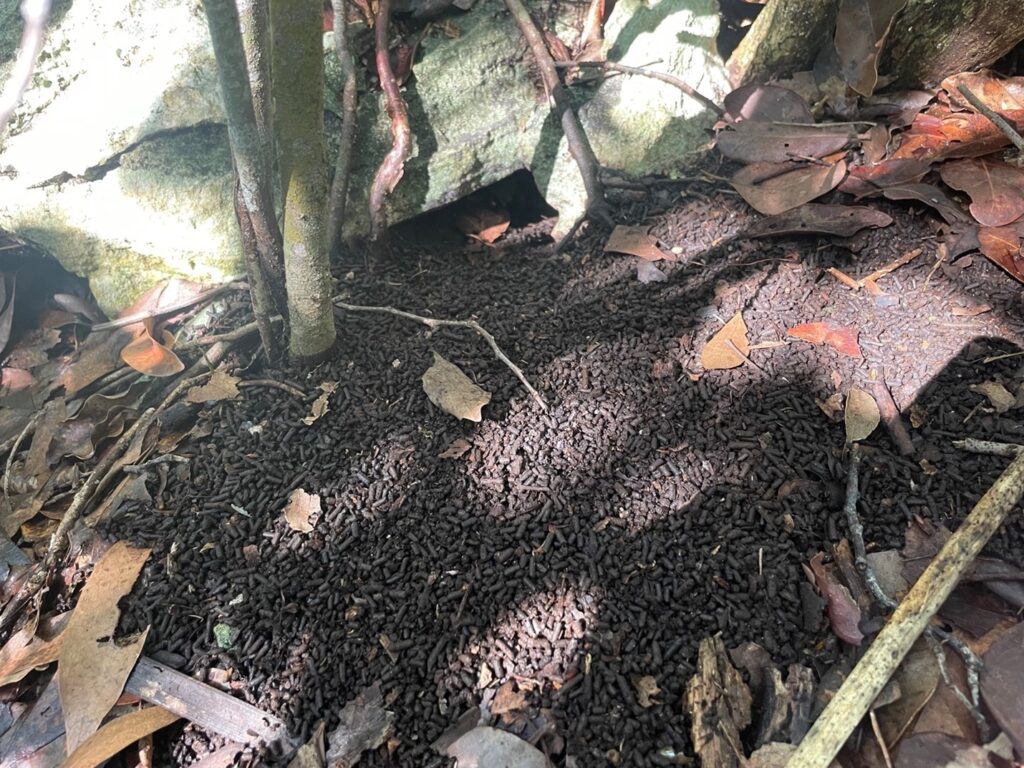
Pictured at the mouth of a crab’s burrow are an abundance of cylindrical fecal pellets. Land crabs serve as one of the major biodigesters of dead and decaying organic matter on the forest floor. From dead leaves to fallen fruit, or the rare treat of an animal carcass, there isn’t much these opportunistic scavengers aren’t willing to eat. Land crabs act as critical ecosystem engineers; they break down organic materials, generating soil, and excavate and aerate the earth while burrowing. Further, their taste for more energy-rich foods such as fruit and seeds enable them to act as a biofilter, selectively destroying or relocating the seeds of plants and shaping the composition of the forest itself.
Working in the community, with the community
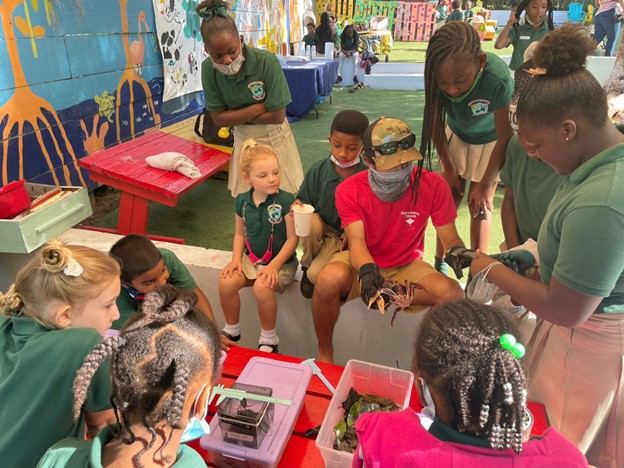
While the tradition of harvesting land crabs dates back centuries, the practice is becoming less prevalent in the younger generations of Bahamians. In this photo, grade school students at the Harbour Island Green School get a close encounter with a black land crab, some for the very first time, as they learn how to differentiate between males and females, how to safely handle the animals, and about their ecology.
Filling the gaps of our knowledge

Field technician Alex Smith records morphometric measurements of a large black land crab with a carapace width of 108 mm. Despite their widescale harvest throughout the Caribbean, there is little data surrounding the fishery and the number of crabs harvested in the region. Adult crabs of this size class are commonly found during the seasonal spawning run when they are most active; however, juveniles are seldom seen. Filling knowledge gaps surrounding the complicated life history of the crabs is imperative for informing potential fishery management strategies.
Food of the past, food for the future
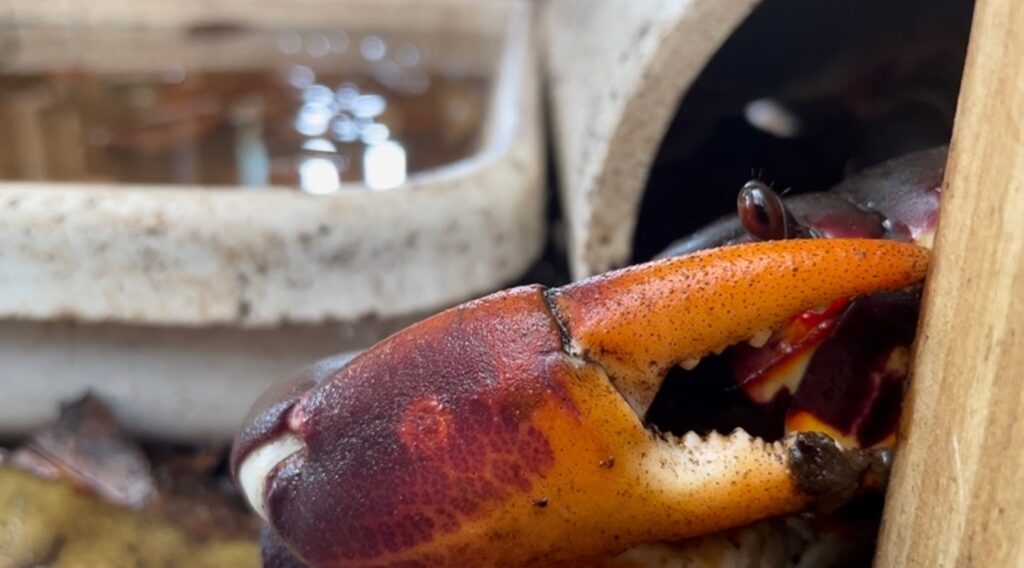
On a changing planet, small island states like The Bahamas are disproportionately affected by the issues of climate change and food security. As we work towards a more sustainable food future, the answers may lie in the knowledge of the past. Just as the crabs were harvested by the indigenous peoples of the Caribbean for centuries, so too may they continue to provide a reliable source of protein throughout the region today. For this to happen however, we must consider the nuance of how land crab survival is dependent on the preservation of coastal forest ecosystems. In an era of aggressive urbanization and coastline development, these forests are often overlooked and considered useless scrubland when compared to the more immediate returns on development for the tourism sector. The crabs will continue to crawl on land as they have for millions of years—if we preserve the habitats critical for their survival.
About the author
Bill Bigelow is a graduate student at Memorial University of Newfoundland. From 2020-2022, Bill worked with the Cape Eleuthera Island School on Eleuthera Island, The Bahamas studying the behavior and physiology of the black land crab (Gecarcinus ruricola). During his field work, it became apparent there was more to the story of the crabs than their ecological role within coastal forests. Working alongside stakeholders in the crab fishery, it was clear that these animals and the people who rely on them have a story to tell. Today, Bill continues his work in coastal ecology where he teaches students at the School for Field Studies based on South Caicos, Turks and Caicos Islands.
Image Credit: Images 1-2 and 4-10 courtesy of Bill Bigelow. Image 3 courtesy of Cape Eleuthera Island School.


